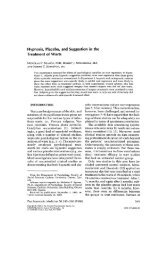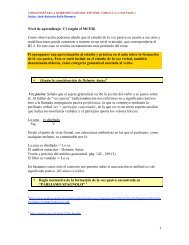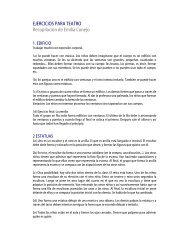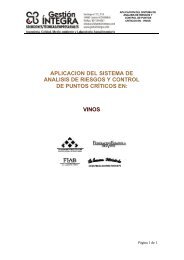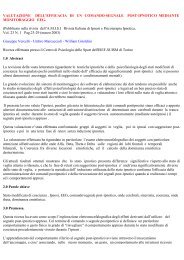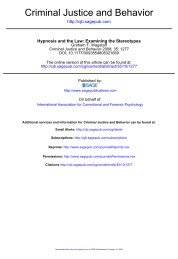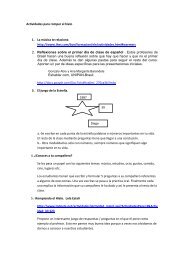10 Hypnosis, Dissociation and Trauma
10 Hypnosis, Dissociation and Trauma
10 Hypnosis, Dissociation and Trauma
You also want an ePaper? Increase the reach of your titles
YUMPU automatically turns print PDFs into web optimized ePapers that Google loves.
<strong>10</strong><br />
International H<strong>and</strong>book of Clinical <strong>Hypnosis</strong>. Edited by G. D. Burrows, R. O. Stanley, P. B. Bloom<br />
Copyright # 2001John Wiley & Sons Ltd<br />
ISBNs: 0-471-97009-3 Hardback); 0-470-84640-2 Electronic)<br />
<strong>Hypnosis</strong>, <strong>Dissociation</strong> <strong>and</strong><br />
<strong>Trauma</strong><br />
DAVID SPIEGEL<br />
Stanford University School of Medicine, USA<br />
This chapter was initially prepared as part of a visit to the Oklahoma Psychiatric<br />
Association ®ve months after the bombing of the Alfred P. Murrah Federal Of®ce<br />
Building on 19 April 1995. A powerful bomb was exploded in front of the building<br />
that morning, killing almost 200 people, destroying the Federal Building, <strong>and</strong><br />
damaging buildings within a 12-block radius. I will delineate the nature <strong>and</strong><br />
prevalence of post-traumatic stress disorder symptoms in the aftermath of such<br />
trauma, the role of dissociative features in such symptoms, <strong>and</strong> treatment approaches,<br />
including the use of hypnosis.<br />
THE AFTERMATH OF TRAUMA<br />
The DSM-IV APA, 1994) diagnostic criteria for acute <strong>and</strong> post-traumatic stress<br />
disorder PTSD) involve intrusion, dissociative, avoidance, <strong>and</strong> hyperarousal<br />
symptoms in the aftermath of a traumatic stressor. A taxi driver in Oklahoma City<br />
said: `Oklahoma lost its innocence in this attack, the sense of being the heartl<strong>and</strong>,<br />
of being safe.' He added: `I used to like driving downtown, but I don't work<br />
downtown much any more. It just doesn't have the same feeling that it used to.' A<br />
psychiatrist who was head of the disaster committee commented that things seemed<br />
so unreal to him that he had trouble recounting the details of what had happened<br />
that day afterwards: `Although I was feeling like a fraud because the event <strong>and</strong> job<br />
seemed unreal, I was amazed at the universally receptive response to my calls.<br />
There was a feeling of relief, as though each contact was a symbolic bridge<br />
between isl<strong>and</strong>s' Poarch, 1995, p. 9).<br />
Post-traumatic stress disorder is a disturbingly common problem. For example,<br />
in the United States a study by Naomi Breslau <strong>and</strong> colleagues Breslau, Davis et<br />
al., 1991; Breslau & Davis, 1992) demonstrated that 9% of the population of<br />
Detroit had post-traumatic stress disorder. The leading cause of deaths of young<br />
adults is automobile accidents <strong>and</strong> there is much associated physical <strong>and</strong> psycholo-<br />
International H<strong>and</strong>book of Clinical <strong>Hypnosis</strong>. Edited by G. D. Burrows, R. O. Stanley <strong>and</strong> P. B. Bloom<br />
# 2001John Wiley & Sons, Ltd
144 INTERNATIONAL HANDBOOK OF CLINICAL HYPNOSIS<br />
gical trauma in relation to that. Firearms are the leading cause of death for young<br />
people in Texas. Physical trauma is a major cause of mortality <strong>and</strong> morbidity in the<br />
United States <strong>and</strong> that means that psychological syndromes which accompany<br />
trauma are a very prevalent part of our collective psychological experience. There<br />
are estimates that 12 million adult women have been raped in the United States <strong>and</strong><br />
another <strong>10</strong> million have been victims of aggravated assault. Bowners, O'Gorman<br />
et al., 1991; Browne, 1993; Koss, 1993a, b; Koss, Heise et al., 1994). Edna Foa's<br />
work Foa & Riggs, 1993), <strong>and</strong> that of others, suggests that some two-thirds of<br />
women who have been raped develop post-traumatic stress disorder, 45% have the<br />
disorder 3 months later, <strong>and</strong> among all rape victims regardless of time since the<br />
trauma, 15% suffer PTSD. It can be, it isn' t always, but it can be a lifelong<br />
disorder. Similarly studies of Vietnam era veterans indicate that somewhere between<br />
15 <strong>and</strong> 25% of veterans suffer from post-traumatic stress disorder Keane &<br />
Fairbank, 1983). This is a huge proportion of the population. While the majority of<br />
people who have been through terrible trauma do not get post-traumatic stress<br />
disorder, a substantial minority do. This compels us to underst<strong>and</strong> the phenomenology<br />
as a ®rst step to diagnosis <strong>and</strong> treatment.<br />
A BRIEF HISTORY OF PTSD<br />
There has been a tendency to slip into one of two mistaken extremes in regard to<br />
PTSD. One is a cynical attitude which implies that most patients are making up<br />
their symptoms for secondary gain. An example is a case in which an armored car<br />
driver was shot in the chest three times during a robbery. His two colleagues were<br />
killed as they were walking out of an elevator. The company he worked for objected<br />
to providing treatment for post-traumatic stress disorder. This was not some fantasy<br />
of childhood sexual abuse: he took three bullets in the chest <strong>and</strong> saw two of his<br />
friends die <strong>and</strong> yet there was doubt that he had genuine psychiatric symptoms<br />
afterwards. One of our professional responsibilities is to have the kind of educated<br />
empathy to underst<strong>and</strong> what it is like to go through this <strong>and</strong> be able to articulate<br />
that. Post-traumatic symptoms often involve considerable <strong>and</strong> frequently inappropriate)<br />
guilt about imagined or real lapses during the traumatic event. This can<br />
generalize into a sense of shame, reducing the willingness of patients with PTSD to<br />
talk about their symptoms.<br />
On the other h<strong>and</strong>, there is a victimology approach that can allow people to evade<br />
responsibility for all aspects of their lives because they have been victimized. For<br />
example, some patients with an axis II antisocial personality disorder may be<br />
looking for an excuse to blame everybody else for their problems in living.<br />
The concept of post-traumatic stress disorder has had a rather checkered history.<br />
It has tended to emerge largely in the aftermath of war. During <strong>and</strong> after World War<br />
I there was discussion of `shell shock'. The treatment then infantilized patients by<br />
removing those who could not function in combat as far from it as possible. They
HYPNOSIS, DISSOCIATION AND TRAUMA 145<br />
usually remained emotional cripples much of their life because the premise was<br />
they had been so neurologically damaged that there was no repairing them. This<br />
turned out to be a mistake. So in World War II the term was changed to traumatic<br />
neurosis, <strong>and</strong> the idea there was to treat people `within the sound of the guns'<br />
Kardiner & Spiegel, 1947). This was a much better idea because it acknowledged<br />
the reality of intense reaction but did not presume that you had to consolidate it by<br />
pulling the soldiers away from their combat duties. Most were able to respond,<br />
which was a major advance. However, with the development of the psychoanalytic<br />
model there was more emphasis placed on early childhood development <strong>and</strong> less of<br />
the effect of proximate trauma. Indeed much has been made of Freud's ab<strong>and</strong>onment<br />
of the trauma theory in the etiology of neuroses <strong>and</strong> the subsequent development<br />
of a metapsychology which emphasized the role of unconscious fears <strong>and</strong><br />
wishes in developing symptoms rather than traumatic experiences. It came to be<br />
believed that the reason people got PTSD was because of developmental dif®culties.<br />
This point of view can be seen as a denial of the reality of trauma. Indeed the<br />
idea that traumatic experience is less important than developmental history in the<br />
etiology of PTSD is problematic because it ®ts into a common fantasy that we<br />
control <strong>and</strong> therefore deserve whatever happens to us, thereby creating inappropriate<br />
guilt for events over which we have no control. Such thinking allows one to<br />
distance oneself from being in the category of potential victim. But this denies the<br />
existential reality that we are all in the category of potential victim.<br />
However, the psychoanalytic domination of traumatology was ended in 1944<br />
when Eric Lindemann wrote his classic paper on the symptomatology <strong>and</strong> management<br />
of acute grief Lindemann, 1944[94]). He described the now-familiar symptoms<br />
of PTSD in his study of the aftermath of the Coconut Grove Night Club ®re,<br />
in which hundreds of people were killed or badly wounded. He saw people who<br />
were agitated, restless, pacing, experiencing a sense of unreality, somatic discomfort,<br />
<strong>and</strong> intrusive recollections of the ®re. He classi®ed them into three groups:<br />
a) people who had extreme symptoms: hyperactive, restless, unable to sleep, some<br />
became psychotic; b) people who were acutely agitated <strong>and</strong> went through a very<br />
dif®cult period of adjustment but then recovered; c) those who acted as through<br />
nothing had happened. An example of this last group is a man whose wife had been<br />
killed <strong>and</strong> the next day he went to work <strong>and</strong> said `well she would want me to go on<br />
with things <strong>and</strong> I should just go on'. Lindemann found that people at either extreme<br />
did the worst. The ones who were the most severely agitated did very badly. But the<br />
ones on the other end of the symptom continuum, who pretended nothing had<br />
happened, also did very badly. A number had committed suicide within several<br />
years. Lindemann then describes how the principles of grief work as a means of<br />
working through <strong>and</strong> beyond trauma, which means mourning what was lost. He<br />
noted that it was necessary to decathect a loved one who had died before it was<br />
possible to recathect to someone new. Grief work may also involve the loss of a<br />
sense of personal invulnerability, or the loss of somatic function due to injury. This<br />
conceptualization makes it underst<strong>and</strong>able why some people who appear to be
146 INTERNATIONAL HANDBOOK OF CLINICAL HYPNOSIS<br />
getting through a traumatic experience with little or no disturbance may be at<br />
elevated risk for subsequent psychiatric dif®culties. Dissociative symptoms during<br />
<strong>and</strong> in the aftermath of trauma may interfere with this process of working through<br />
traumatic experiences Spiegel & Cardena, 1991). Thus depersonalization, derealization,<br />
dissociative amnesia, or numbing may interfere with necessary emotional<br />
<strong>and</strong> cognitive processing in the aftermath of trauma. Thus the ones who look the<br />
best may actually be doing the worst. These people often don't ask for help, but<br />
need it.<br />
With the Vietnam era there was renewed interest in post-traumatic stress disorder.<br />
PTSD was a special problem in Vietnam because of the lack of community<br />
support for the war, <strong>and</strong> the rotation system which meant that soldiers came <strong>and</strong><br />
went alone for a ®xed period of time, rather than with their units Spiegel, 1981).<br />
Soldiers could be in the jungles dying with their comrades one day <strong>and</strong> 72 hours<br />
later they were back on the streets of their home town, alone, with no one to talk to.<br />
The fact that we lost the war complicated reintegration of combat experiences as<br />
well. Many Vietnam era veterans reported outright hostility from veterans of other<br />
wars. Thus PTSD was found to be relatively common <strong>and</strong> persistent long after the<br />
end of the Vietnam War Keane & Fairbank, 1983).<br />
PTSD: CURRENT DIAGNOSTIC CRITERIA<br />
TRAUMATIC STRESS<br />
<strong>Trauma</strong> can be understood as the experience of being made into an object, a thing,<br />
the victim of nature's indifference, of somebody else's rage. The key issue in<br />
trauma is neither fear nor pain, but rather helplessness. For a period of time one has<br />
no control over what is happening to their body. It is not uncommon for trauma<br />
victims to detach themselves emotionally <strong>and</strong> cognitively mentally from traumatic<br />
experience as it is occurring, as a means of protecting oneself from the reality of<br />
threat.<br />
A young woman who was quite hypnotizable <strong>and</strong> was using self-hypnosis quite<br />
effectively to control anxiety related to her Hodgkin's Disease, described a prior<br />
hospitalization during a routine psychiatric interview: `Well yes, I once fell off a third<br />
story balcony <strong>and</strong> fractured my pelvis.' I inquired whether she had been suicidal: `Did<br />
you jump?' She said `No, I was pushed.' I became concerned that she was paranoid.<br />
She then said, `I was at this party <strong>and</strong> a big huge guy, twice my size, turned around<br />
suddenly with a beer in his h<strong>and</strong> <strong>and</strong> just knocked me over the railing. It was just a<br />
stupid accident.' When I said `That must have been horrifying,' she said `No, actually<br />
it was quite pleasant.' At this point I became even more concerned. I said `What do<br />
you mean?' She said, `I imaged it as if I was on another balcony watching a pink<br />
cloud ¯oat down to the ground. I felt no pain at all, <strong>and</strong> in fact I tried to walk back<br />
upstairs.'
HYPNOSIS, DISSOCIATION AND TRAUMA 147<br />
More examples of this kind of extreme dissociative response to trauma emerged,<br />
leading to more systematic examination of the connection between trauma <strong>and</strong><br />
dissociation. The phenomenology of post-traumatic stress disorder involves, ®rst of<br />
all, a traumatically stressful event APA, 1994). In the DSM-IV there are two<br />
components. The ®rst is the actual experience: The person experienced, witnessed,<br />
or was confronted with an event or events that involved an actual or threatened<br />
death or serious injury, or a threat to the physical integrity of self or others p.<br />
209). The second requirement is `the person's response involved intense fear,<br />
helplessness, or horror' p. 209). The idea was to make it a stringent requirement.<br />
There are problems, however, with this de®nition in that some peoples' reaction to<br />
fear, helplessness or horror may come a long time after the trauma itself.<br />
INTRUSION<br />
Then there are three classes of symptoms. First are the intrusive symptoms. The<br />
persistent <strong>and</strong> unbidden reexperiencing of the traumatic event, which includes<br />
distressing recurrent images, recollections, ¯ashbacks, dreams, nightmares, delusions<br />
or hallucinations. In the example given earlier of the armored car driver who<br />
was shot, he said: `I don't just think about this guy. When an elevator door opens in<br />
front of me, I see that guy.' This kind of intense reliving of the event, as though it<br />
were happening, is typical of people with post-traumatic stress disorder, including<br />
`intense distress at internal or external cues that symbolize or resemble an aspect of<br />
the traumatic event' p. 2<strong>10</strong>). Only one such intrusive symptom is required for the<br />
diagnosis.<br />
AVOIDANCE<br />
The second class of symptoms are the avoidance symptoms, like the Oklahoma<br />
City taxi driver who would not drive downtown much anymore: `Persistent avoidance<br />
of stimuli associated with the trauma <strong>and</strong> numbing of general responsiveness'<br />
p. 2<strong>10</strong>). Examples include efforts to avoid thoughts or feelings about the event,<br />
efforts to avoid activities that arouse recollections, inability to recall important<br />
aspects of the trauma, feeling detached or estranged from others, diminished<br />
interest in usually pleasurable activities, restricted range of affect, <strong>and</strong> a sense of a<br />
foreshortened future p. 21). Three such symptoms are required for the diagnosis<br />
of PTSD.<br />
HYPERAROUSAL<br />
The fourth criterion involves hyperarousal symptoms: trouble falling or staying<br />
asleep, irritability or outbursts of anger, dif®culty concentrating, hypervigilance,<br />
<strong>and</strong> an exaggerated startled response. Two such symptoms are required. The reader<br />
may notice that in many ways these symptoms seem inconsistent. How can one be
148 INTERNATIONAL HANDBOOK OF CLINICAL HYPNOSIS<br />
numb, detached <strong>and</strong> avoidant <strong>and</strong> at the same time have intrusive ¯ashbacks <strong>and</strong><br />
nightmares? The crucial issue is that the cluster of PTSD symptoms is a combination<br />
of intrusion <strong>and</strong> avoidance. These sometimes come in sequence, sometimes<br />
with more intrusion, sometimes more avoidance. But the normal homeostatic<br />
equilibrium, the control of one's inner life, is very much disrupted by traumatic<br />
stressors. The worse the intrusions are, the more desperate are the efforts to avoid<br />
them. Indeed, the ¯ashbacks <strong>and</strong> hyperarousal come to symbolically represent the<br />
traumatic circumstance itself, repetitively imposing distress just as the assailant,<br />
accident, or natural disaster did.<br />
TRAUMA AND DISSOCIATION<br />
There is growing interest in the overlap between hypnotic <strong>and</strong> dissociative states<br />
<strong>and</strong> post-traumatic stress disorder. <strong>Hypnosis</strong> has three main components: absorption,<br />
dissociation, <strong>and</strong> suggestibility Spiegel, 1994). There is a clear analogy<br />
between these components of hypnosis <strong>and</strong> the above described categories of<br />
symptoms of PTSD.<br />
ABSORPTION<br />
Absorption involves an intense focus, like looking through a telephoto lens in a<br />
camera Tellegen & Atkinson, 1974). When people are having ¯ashbacks, that is<br />
all they are aware of. Elizabeth Loftus has written about what she calls the weapon<br />
focus in crime victims Loftus, 1979). The police are frustrated when someone who<br />
has just been mugged gives them a brilliant description of the gun, but has no<br />
recollection of the face of the assailant. They were so focused on the thing that was<br />
threatening them that the ordinary peripheral awareness is something they don't<br />
have. There are studies that show that literally when people are aroused <strong>and</strong><br />
stressed the things that are at the periphery of awareness just are not registered in<br />
the same way because they are so focused Loftus & Burns, 1982), One part of the<br />
transformation <strong>and</strong> experience that occurs during trauma is this narrowing of the<br />
focus of attention.<br />
DISSOCIATION<br />
The second is detachment or dissociation. People tend to compartmentalize aspects<br />
of experience. <strong>Trauma</strong> can be thought of as a sudden discontinuity in experience.<br />
In traumatic circumstances, what is normally a smooth continuum of experience<br />
suddenly becomes a discontinuity. This can be re¯ected by a discontinuity in<br />
mental function. Often one's self-image is radically altered by the traumatic<br />
experienceÐthe loss of control, sense of vulnerability, indignity, <strong>and</strong> fear can<br />
suddenly create a radically different view of self. This can lead to a compartmentalization<br />
of these different aspects of experience.
HYPNOSIS, DISSOCIATION AND TRAUMA 149<br />
If the state of mind occurring at the time of the trauma is altered or hypnoticlike,<br />
the way memories are stored may be in¯uenced by this narrowness of<br />
attentional focus. The range of associations may be more limited <strong>and</strong> therefore<br />
those that exist more intense. Strong emotion, for example, which is usually<br />
associated with traumatic memories, may in¯uence both storage <strong>and</strong> retrieval<br />
Cahill, Prins et al., 1994). There is evidence that congruence in mood between the<br />
state in which memories were stored <strong>and</strong> that in which they are retrieved improves<br />
recall Bower, 1981). Similarly, another form of state dependency involves the<br />
dissociative state itself. To the extent that individuals do enter a spontaneous<br />
dissociative state during trauma, the memories may be stored in a manner that<br />
re¯ects this state e.g. narrower range of associations to context). There may be<br />
fewer cross-connections to other related memories Evans, 1988; Evans & Kihlstrom,<br />
1973; Hilgard, 1986). Furthermore, retrieval should be facilitated by being<br />
in a similar dissociated state, for example hypnosis. <strong>Trauma</strong> can be conceptualized<br />
as a sudden discontinuity in experience. This may explain the reversibility of<br />
dissociative amnesia with techniques such as hypnosis Spiegel & Spiegel, 1978;<br />
Loewenstein, 1991).<br />
That such amnesia for traumatic events does occur is most convincingly demonstrated<br />
by Williams. She obtained hospital records of 129 women indicating<br />
emergency room contact for sexual or physical abuse, <strong>and</strong> interviewed them an<br />
average of 17 years later. The results were striking: 38% of the subjects did not<br />
report the abuse that had been recorded, nor did they report any sexual abuse by the<br />
same perpetrator. Indeed, 12% reported no abuse at all Williams, 1994). An<br />
additional 16% <strong>10</strong>% of the whole sample) of the women who did remember the<br />
abuse, reported that there was a period in their lives when they could not remember<br />
it Williams, 1995). In fact, if the analysis was conservatively restricted to only<br />
those with recorded medical evidence of genital trauma <strong>and</strong> whose accounts were<br />
rated as most credible in the 1970s), 52% did not remember the sexual abuse. It<br />
should be noted that this lack of memory was not diagnosed as a dissociative<br />
disorder, but the interviews were not designed to establish the presence or absence<br />
of any psychiatric disorder, merely the presence or absence of traumatic memories.<br />
It makes sense that mental processes which segregate one set of associations from<br />
another might well impair memory storage or retrieval Kihlstrom, 1987).<br />
SUGGESTIBILITY<br />
The third component of hypnosis is suggestibility, a tendency to respond readily<br />
<strong>and</strong> uncritically to social cues. The hyperarousal states in PTSD are analogous to<br />
that. On the other h<strong>and</strong>, during trauma many people ®nd themselves in a `state of<br />
shock', responding in an automaton-like fashion. In a traumatic situation, as people<br />
narrow the focus of attention they tend to act without thinking about consequences.<br />
The police, for example, frequently do not believe a rape victim's story because she<br />
doesn't ®t their image of what rape victims should look like. A supposedly classic
150 INTERNATIONAL HANDBOOK OF CLINICAL HYPNOSIS<br />
rape victim is bruised, with torn clothing <strong>and</strong> a tearful, hysterical demeanor. Most<br />
rape victims don't look like that. They are desperately trying to maintain some<br />
semblance of their dignity, emotional control, <strong>and</strong> their prior ordinary life. They<br />
wish it were a bad dream <strong>and</strong> it would all go away, <strong>and</strong> often overcontrol their<br />
affect rather than expressing it. At the same time, they are exquisitely sensitive to<br />
cues that may trigger recollection of the traumaÐthis hypersensitivity is a kind of<br />
suggestibility.<br />
DISSOCIATION AND TRAUMA<br />
There is growing clinical <strong>and</strong> some empirical evidence that dissociation may occur<br />
especially as a defense during trauma, an attempt to maintain mental control just as<br />
physical control is lost Spiegel, 1984; Kluft, 1985; Putnam, 1985; Spiegel, 1988;<br />
Bremner, Southwick et al., 1992; Cardena & Spiegel, 1993; Koopman, Classen et<br />
al., 1994; Marmar, Weiss et al.,1994; Butler & Spiegel, 1997; Butler, Jasiukaitis,<br />
Koopman & Spiegel, 1997). Fifteen studies of immediate psychological reactions<br />
within the ®rst month following a major disaster provide evidence of a high<br />
prevalence of dissociative symptoms, <strong>and</strong> some show that such symptoms are strong<br />
predictors of the development of post-traumatic stress disorder. These studies<br />
examined the experiences of survivors, victims <strong>and</strong> their families, <strong>and</strong> rescue<br />
workers in a variety of disasters: the Coconut Grove ®re mentioned earlier Lindemann,<br />
1944[94]), the 1972 Buffalo Creek ¯ood disaster caused by the collapse of a<br />
dam Titchener & Kapp, 1976); automobile <strong>and</strong> other accidents <strong>and</strong> serious illnesses<br />
Noyes, Hoenk et al., 1977; Noyes & Kletti, 1977; Noyes & Slyman, 1978);<br />
correctional of®cers' experience as hostages in a New Mexico penitentiary Hillman,<br />
1981); the collapse of the Hyatt Regency Hotel skywalk in Kansas City Wilkinson,<br />
1983); a lightning strike disaster that killed one child with others present Dollinger,<br />
1985) a 1984 tornado that devastated a North Carolina community Madakasira,<br />
1987); an airplane crash-l<strong>and</strong>ing Sloan, 1988); an ambush in a war zone in Namibia<br />
Feinstein, 1989); the 1989 Loma Prieta earthquake in the San Francisco Bay Area<br />
Cardena & Spiegel, 1993); the Oakl<strong>and</strong>±Berkeley ®restorm Koopman, 1994);<br />
witnessing an execution Freinkel, Koopman et al., 1994); <strong>and</strong> shootings in a highrise<br />
of®ce building Classen, Abramson et al., 1997).<br />
Survivors of these traumatic situations reported a variety of dissociative symptoms.<br />
Stupor, a dulling of the senses <strong>and</strong> decreased behavioral responsiveness have<br />
been described in survivors of automobile accidents Noyes et al., 1977). Amnesia<br />
or memory impairment was reported by 29% of the Bay Area earthquake victims<br />
Cardena & Spiegel, 1993) <strong>and</strong> by 8 out of 14 of the soldiers directly involved in<br />
the Namibia ambush Feinstein, 1989). Impairment of memory or concentration<br />
was reported by 79% of the airplane crash-l<strong>and</strong>ing survivors Sloan, 1988). One<br />
boy in the lightning strike disaster had total amnesia for the event Dollinger,<br />
1985).<br />
Numbing, loss of interest, <strong>and</strong> an inability to feel deeply about anything, were
HYPNOSIS, DISSOCIATION AND TRAUMA 151<br />
reported in about a third of the survivors of the Hyatt Regency skywalk collapse<br />
Wilkinson, 1983), <strong>and</strong> in a similar proportion of survivors of the North Sea oil rig<br />
collapse Holen, 1993). This is consistent with our ®ndings among survivors of the<br />
Loma Prieta earthquake Cardena & Spiegel 1993). A quarter of a sample of<br />
normal students reported marked depersonalization during <strong>and</strong> immediately after<br />
the earthquake, <strong>and</strong> 40% described derealization, the surroundings seeming unreal<br />
or dreamlike. While the most common reported memory problem was intrusive<br />
recollection, 29% of the sample reported dif®culties with everyday memory.<br />
Dissociative symptoms have also been retrospectively reported to occur during<br />
combat. Bremner et al. 1992) administered the Dissociative Experiences Scale<br />
DES) to 85 Vietnam veterans, 53 with PTSD <strong>and</strong> 32 with medical problems. They<br />
found that the DES scores of 53 Vietnam veterans with PTSD were twice as high<br />
as those obtained among a comparison sample of 32 other veterans. Veterans with<br />
PTSD have been found to obtain higher scores on measures of hypnotizability as<br />
well Stutman & Bliss, 1985; Spiegel, 1988).<br />
DISSOCIATIVE SYMPTOMS AS PREDICTORS OF PTSD<br />
Dissociative symptoms, especially numbing, have been found to be rather strong<br />
predictors of later post-traumatic stress disorder McFarlane, 1986; Solomon,<br />
Mikulincer et al. 1989; Koopman et al., 1994, 1996; Classen et al., 1997).<br />
McFarlane found that the time course of dissociative symptoms is critical in the<br />
prediction of subsequent PTSD McFarlane, 1997). Automobile accident victims'<br />
dissociation scores on the day of the trauma did not predict subsequent PTSD<br />
symptoms, their dissociation scores at <strong>10</strong> days did. Thus a failure to readjust<br />
quickly after trauma seems to place people at higher risk for later PTSD. Thus,<br />
physical trauma seems to elicit dissociation or compartmentalization of experience,<br />
<strong>and</strong> may often become the matrix for later post-traumatic symptomatology, such as<br />
dissociative amnesia for the traumatic episode. Indeed, more extreme dissociative<br />
disorders, such as Dissociative Identity Disorder, have been conceptualized as<br />
chronic Post-traumatic Stress Disorders Spiegel, 1984, 1986; Kluft,1985). Children<br />
exposed to multiple trauma are more likely to use dissociative mechanisms<br />
which include spontaneous trance episodes Terr, 1991). Recollection of trauma<br />
tends to have an off-on quality involving either intrusion or avoidance Horowitz,<br />
1976) in which victims either intensively relive the trauma as though it were<br />
recurring, or have dif®culty remembering it. Thus, physical trauma seems to elicit<br />
dissociative responses.<br />
ACUTE STRESS DISORDER<br />
This evidence reviewed above regarding the prevalence of dissociative <strong>and</strong> other<br />
symptoms in the immediate aftermath of trauma formed the basis for including
152 INTERNATIONAL HANDBOOK OF CLINICAL HYPNOSIS<br />
Acute Stress Disorder ASD) as a new diagnosis in the DSM-IV Spiegel &<br />
Cardena, 1991; Liebowitz, Barlow et al., 1994). It is diagnosed when high levels of<br />
dissociative, anxiety <strong>and</strong> other symptoms occur within one month of trauma, <strong>and</strong><br />
persist for at least 2 days, causing distress <strong>and</strong> dysfunction. Such individuals must<br />
have experienced or witnessed physical trauma, <strong>and</strong> responded with intense fear,<br />
helplessness, or horror. This `A' criterion of the DSM-IV requirements for ASD is<br />
identical to that of PTSD. The individual must have at least three of the following<br />
®ve dissociative symptoms: depersonalization, derealization, amnesia, numbing, or<br />
stupor. In addition, the trauma victim must have one symptom from each of the<br />
three classic PTSD categories: intrusion of traumatic memories, including nightmares<br />
<strong>and</strong> ¯ashbacks; avoidance; <strong>and</strong> anxiety or hyperarousal. If the symptoms<br />
persist beyond a month, the person receives another diagnosis based on symptom<br />
patterns. Likely c<strong>and</strong>idates are dissociative, anxiety or post-traumatic stress disorders.<br />
TREATMENT<br />
Three types of psychotherapy have been applied to PTSD: psychodynamic,<br />
cognitive-behavioral CBT), <strong>and</strong> hypnotic-restructuring. In each of these approaches,<br />
telling <strong>and</strong> retelling the story of the trauma is an essential element, albeit<br />
with different methods <strong>and</strong> goals: clari®cation of unconscious themes <strong>and</strong> transference<br />
distortions in psychodynamic treatment, correction of cognitive distortions in<br />
CBT, <strong>and</strong> abreaction <strong>and</strong> the restructuring of traumatic memories with the help of<br />
hypnosis.<br />
Psychodynamic treatment is rooted in the exploration of unconscious implications<br />
of traumatic loss, with the premise that the disorder is complicated by<br />
unconscious implications of the trauma Horowitz, 1976; Horowitz, Wilner et al.,<br />
1980). At the same time it can help to strengthen ego function by bringing<br />
unconscious determinants of symptomatology into conscious awareness, thereby<br />
rendering the symptoms less overwhelming <strong>and</strong> facilitating coping Marmar, Weiss<br />
& Pynoos, 1995; Menninger & Wilkinson, 1988).<br />
The helplessness imposed at the time of trauma is seen as generalizing to<br />
encompass the self as helpless in other domains of life, a fate experienced as<br />
deserved. Ironically, fantasies of omnipotence reinforce rather than contradict this<br />
self-schema. Attempts to compensate for the lack of control imposed by traumatic<br />
stress often lead to guilt-inducing fantasies of unrealistic control: the accident or<br />
assault should have been foreseen <strong>and</strong> therefore avoided. Therefore it happened<br />
because of a lapse of judgment or personality defect rather than the r<strong>and</strong>omness of<br />
life. Fantasized guilt at `causing' trauma is for some more bearable than enduring<br />
the helplessness engendered by it.<br />
Psychodynamic psychotherapy is aimed at unearthing <strong>and</strong> working through such<br />
unconscious determinants of symptoms, through retellings of the story of the
HYPNOSIS, DISSOCIATION AND TRAUMA 153<br />
trauma, analysis of dreams <strong>and</strong> intrusive recollections, <strong>and</strong> exploration of transference<br />
issues. The `traumatic transference' is important, since many trauma victims<br />
displace onto the therapist feelings they have about the trauma or traumatizer. They<br />
are also quite sensitive to apparent rejection by the therapist, feeling ashamed by<br />
their traumatic experience. Clarifying transference distortions can help patients<br />
accept <strong>and</strong> integrate traumatic experiences <strong>and</strong> repair damage to the self-concept.<br />
Cognitive-behavioral approaches are based in part on the concept of systematic<br />
desensitization Foa & Rothbaum, 1989; Foa, Davidson et al., 1995). Repeated<br />
reaccessing of traumatic memories in a more benign therapeutic context gradually<br />
deprives them of their affect-arousing qualities. Furthermore, distorting effects of<br />
the traumatically induced self-assessment are challenged: the fact that it happened<br />
does not imply that the victim deserved it, or that the victim deserves mistreatment<br />
in other situations. The retelling is intended to diffuse emotion <strong>and</strong> provide an<br />
opportunity for clarifying <strong>and</strong> correcting trauma-contaminated cognitions Keane,<br />
Fairbank et al., 1989; Cooper & Clum, 1989).<br />
Since the hypnotizability of Vietnam veterans with PTSD has been found to<br />
be higher than that of other populations Stutman & Bliss, 1985; Spiegel, Hunt<br />
et al., 1988), it makes sense that techniques employing hypnosis should be<br />
useful. Especially if traumatized individuals with PTSD are in a spontaneous<br />
dissociative state during <strong>and</strong> immediately after the trauma, hypnosis is likely to<br />
be helpful in tapping traumatic memories by recreating a similar type of mental<br />
state. The literature on state-dependent memory Bower, 1981) indicates that the<br />
content of memory is better retrieved when the individual is in the same mental<br />
state at the time of retrieval that he or she was in when the information was<br />
acquired. Therefore the ability to tolerate congruent <strong>and</strong> painful) affect would<br />
seem to be a prerequisite for retrieval of traumatic memories. Similar to<br />
predominant affect, the structure of consciousness itself, such as being in a<br />
dissociative or hypnotic state, constitutes another mental state which can<br />
facilitate recollection.<br />
Treatment employing hypnosis is now seen as involving not merely abreaction of<br />
traumatic memories, but working through them by assisting with the management<br />
of uncomfortable affect, enhancing the patient's control over them, <strong>and</strong> enabling<br />
him to cognitively restructure their meaning Spiegel & Spiegel, 1978; Spiegel,<br />
1981, 1992, 1997). Catharsis is a beginning, but it is not an end in itself, <strong>and</strong> can<br />
lead to retraumatization if the catharsis is not accompanied by support in managing<br />
affective response, control over the accessing of memories, <strong>and</strong> working them<br />
through. A grief work model Lindemann 1944[94]) is useful. Observations of<br />
normal grief after trauma have led to a recognition that a certain amount of<br />
emotional discomfort <strong>and</strong> physical restlessness <strong>and</strong> hyperarousal is a natural, <strong>and</strong><br />
indeed necessary, part of acknowledging, bearing, <strong>and</strong> putting into perspective<br />
traumatic memories Spiegel, 1986; Spiegel & Cardena, 1990). This is often<br />
facilitated by using a hypnotic imaging technique, the `split screen', in which the<br />
patient is asked to picture some aspect of the trauma on one side of the screen,
154 INTERNATIONAL HANDBOOK OF CLINICAL HYPNOSIS<br />
bearing the associated uncomfortable affect, <strong>and</strong> then to picture on the other side of<br />
the screen something he or she did for self-protection or to aid others. In this way<br />
the traumatic memory is acknowledged but restructured to encompass efforts at<br />
mastery as well as helplessness.<br />
PRINCIPLES OF PSYCHOTHERAPY WITH HYPNOSIS<br />
The principles of this kind of psychotherapy can be summarized with the following<br />
eight Cs:<br />
Confrontation. It is important to confront the traumatic events directly rather than<br />
attribute the symptoms to some long-st<strong>and</strong>ing family or personality problem.<br />
Confession. It is often necessary to help trauma survivors to confess deeds or<br />
emotions that are embarrassing to them <strong>and</strong> at times repugnant to the therapist. It is<br />
important to help these patients distinguish between misplaced guilt <strong>and</strong> real<br />
remorse. They may well be telling the therapist aspects of the traumatic event that<br />
they have discussed with no one else.<br />
Consolation. The intensity of traumatic experiences requires an actively consoling<br />
approach from the therapist, lest he or she be perceived as being judgmental or as<br />
in¯icting rather than treating trauma-induced pain. Appropriate expressions of<br />
sympathy <strong>and</strong> concern can be helpful in acknowledging <strong>and</strong> diffusing this common<br />
reaction.<br />
Condensation. Find an image that condenses a crucial aspect of the traumatic<br />
experience. This representation can make the overwhelming aspects of the trauma<br />
more manageable by putting it in concrete, symbolic form. Furthermore, this<br />
approach can be used to facilitate restructuring of the experience by joining<br />
previously disparate images, for example, linking the pain associated with the death<br />
of a friend in combat with the happiness experienced during some earlier shared<br />
time. This allows patients to alter the pain of the loss by attending to positive<br />
aspects of the lost relationship that remain in memory.<br />
Consciousness. Make conscious previously dissociated traumatic memories in a<br />
gradual manner that does not overwhelm the patient.<br />
Concentration. Use the intense <strong>and</strong> focused concentration characteristic of the<br />
hypnotic state to reinforce the boundaries of the traumatic experience <strong>and</strong> the<br />
painful affect associated with it. Directing sharply de®ned attention on the loss also<br />
implies that when the hypnotic state is ended, attention can be shifted away from<br />
the traumatic experience.<br />
Control. Because the most painful aspect of severe trauma is the absolute sense of<br />
helplessness, the loss of control over one's body <strong>and</strong> the course of events, it is<br />
especially important that the process by which the therapeutic intervention is<br />
conducted enhance the patient's sense of control over the traumatic memories.<br />
Structure the experience so that patients are given the opportunity to terminate the<br />
working through when they feel they have had enough, can remember as much
HYPNOSIS, DISSOCIATION AND TRAUMA 155<br />
from the hypnosis as they care to, <strong>and</strong> feel they are in charge of the self-hypnosis<br />
experience. They should learn to use it on their own as a self-hypnosis exercise as<br />
well as with the therapist. Such procedures help patients to deal with traumatic<br />
memories with a greater sense of control <strong>and</strong> mastery.<br />
Congruence. The goal is to help patients integrate dissociated or repressed<br />
traumatic material into conscious awareness in such a way that they can tolerate<br />
experiencing the memories as part of themselves. In this way the traumatic past is<br />
not incompatible with their present experience. Patients should emerge from<br />
therapy having reviewed not only what was done to them but what they did to<br />
protect themselves, not only what they lost but what they had valued <strong>and</strong> why.<br />
CONCLUSION<br />
Post-traumatic stress disorder is a challenge in many ways. It challenges patients'<br />
defenses, interferes with working through of traumatic experiences, <strong>and</strong> impairs<br />
function. It poses special problems for families as well as therapists who treat it.<br />
Working with survivors of trauma forces therapists to confront their own vulnerabilities<br />
as well. Maintaining an empathic connection with such patients is crucial<br />
to the treatment of people who feel ashamed <strong>and</strong> degraded, <strong>and</strong> yet it stimulates<br />
dif®cult emotions in those who do this work. When the traumatic stressor is a<br />
collective one, as in the Oklahoma City bombing, symptoms of intrusion, avoidance,<br />
<strong>and</strong> hyperarousal may affect the community as a whole. At the same time,<br />
community action <strong>and</strong> support can help to heal the wounds in¯icted by the<br />
violence. People gathered <strong>and</strong> left mementos by the hundreds on the fence<br />
surrounding the damaged building: ¯owers, poems, stuffed teddy bears. One group<br />
showed photographs of the blasted shell of the building with cloudy `®gures' which<br />
they claimed represented the spirits of those who had died watching after injured<br />
children in the rubble. There is a strong human need to make some kind of sense<br />
out of tragedy. While some trauma de®es meaning, psychotherapeutic techniques,<br />
including the use of hypnosis, can help in ®nding meaning <strong>and</strong> managing emotion<br />
in the aftermath of traumatic stress.<br />
REFERENCES<br />
APA 1994). Diagnostic <strong>and</strong> Statistical Manual of Mental Disorders: DSM-IV. DC:<br />
American Psychiatric Association, Washington.<br />
Bower, G. H. 1981). Mood <strong>and</strong> memory. Am. Psychologist, 362), 129±148.<br />
Bowners, I. T., O'Gorman, E. C. et al. 1991). Assault characteristics <strong>and</strong> post-traumatic<br />
stress disorder in rape victims. Acta Psychiat. Sc<strong>and</strong>., 83, 27±30.<br />
Bremner, J. D., Southwick, S. et al. 1992). <strong>Dissociation</strong> <strong>and</strong> post-traumatic stress disorder in<br />
Vietnam combat veterans. Am. J. Psychiat., 1493), 328±332.
156 INTERNATIONAL HANDBOOK OF CLINICAL HYPNOSIS<br />
Breslau, N. & Davis, G. C. 1992). Posttraumatic stress disorder in an urban population of<br />
young adults: Risk factors for chronicity. Am. J. Psychiat., 1495), 671±675.<br />
Breslau, N., Davis, G. C. et al. 1991). <strong>Trauma</strong>tic events <strong>and</strong> posttraumatic stress disorder in<br />
an urban population of young adults. Arch. Gen. Psychiat., 483), 216±222.<br />
Browne, A. 1993). Violence against women by male partners. Prevalence, outcomes, <strong>and</strong><br />
policy implications. Am. Psychologist, 48<strong>10</strong>), <strong>10</strong>77±<strong>10</strong>87.<br />
Butler, L. & Spiegel, D. 1997). <strong>Trauma</strong> <strong>and</strong> memory. In L. Dickstein, M. Riba & J. Oldham<br />
Eds), Repressed Memories, p. 71) Washington DC: American Psychiatric Press.<br />
Butler L. D., Jasiukaitis, P., Koopman, C. & Spiegel, D. 1997). Hypnotizability <strong>and</strong><br />
traumatic experience: A diathesis-stress model of dissociative symptomatology. Am. J.<br />
Psychiat., 1537), 42±63.<br />
Cahill, L., Prins, B. et al. 1994). Beta-adrenergic activation <strong>and</strong> memory for emotional<br />
events. Nature, 371, 702±704.<br />
Cardena, E. & Spiegel, D. 1993). Dissociative reactions to the San Francisco Bay Area<br />
earthquake of 1989. Am. J. Psychiat., 1503), 474±478.<br />
Classen, C., Abramson, S. et al. 1997). Effectiveness of a training program for enhancing<br />
therapists' underst<strong>and</strong>ing of the supportive-expressive treatment model for breast cancer<br />
groups. J. Psychother. Prac. Res., 6, 211±218.<br />
Cooper, N. A. & Clum, G. A. 1989). Imaginational ¯ooding as a supplementary treatment<br />
for PTSD in combat veterans: A controlled study. Behav. Ther., 20, 381±391.<br />
Dollinger, S. J. 1985). Lightning-strike disaster among children. Br. J. Med. Psychol.,<br />
58Pt 4), 375±383.<br />
Evans, F. J. 1988). Posthypnotic amnesia: <strong>Dissociation</strong> of context <strong>and</strong> content. In H. M.<br />
Pettinati Ed.), <strong>Hypnosis</strong> <strong>and</strong> Memory pp. 157±192), New York: Guilford Press.<br />
Evans, F. J. & Kihlstrom, J. F. 1973). Posthypnotic amnesia as disrupted retrieval. J. Abnorm.<br />
Psychol., 822), 317±323.<br />
Feinstein, A. 1989). Posttraumatic stress disorder: A descriptive study supporting DSM-III-<br />
R criteria. Am. J. Psychiat., 1465), 665±666.<br />
Foa, E. B., Davidson, J. et al. 1995). Treatment of Post-<strong>Trauma</strong>tic Stress Disorder. In C. O.<br />
Gabbard Ed.), Treatment of Psychiatric Disorders: The DSM-IV Edition, vol. 11<br />
pp. 1499±1520) Washington DC: American Psychiatric Press.<br />
Foa, E. B. & Riggs, D. S. 1993). Posttraumatic Stress Disorder <strong>and</strong> Rape. In J. M. Oldham,<br />
M. B. Riba & A. Tasman, Eds), Review of Psychiatry pp. 273±303), Washington DC:<br />
American Psychiatric Press.<br />
Foa, E. B. & Rothbaum, B. O. 1989). Behavioral psychotherapy for post-traumatic stress<br />
disorder. Int. Rev. Psychiat., 1, 219±226.<br />
Freinkel, A., Koopman, C. et al. 1994). Dissociative symptoms in media eyewitnesses of an<br />
execution. Am. J. Psychiat., 1519), 1335±1339.<br />
Hilgard, E. 1986). Divided Consciousness: Multiple Controls in Human Thought <strong>and</strong><br />
Action. New York: Wiley.<br />
Hillman, R. G. 1981). The psychopathology of being held hostage. Am. J. Psychiat., 1389),<br />
1193±1197.<br />
Holen, A. 1993). The North Sea Oil Rig Disaster. New York: Plenum.<br />
Horowitz, M. 1976). Stress Response Syndromes. New York: Aronson.<br />
Horowitz, M. J., Wilner, N. et al. 1980). Signs <strong>and</strong> symptoms of posttraumatic stress<br />
disorder. Arch. Gen. Psychiat., 371), 85±92.<br />
Kardiner, A. & Spiegel, H. 1947). War Stress <strong>and</strong> Neurotic Illness. New York: Hoeber.<br />
Keane, T. M. & Fairbank, J. A. 1983). Survey analysis of combat-related stress disorders in<br />
Vietnam veterans. Am. J. Psychiat., 1403), 348±350.<br />
Keane, T. M., Fairbank, J. A. et al. 1989). Implosive ¯ooding) therapy reduces symptoms<br />
of PTSD in Vietnam Combat Veterans. Behav. Ther., 20, 245±260.
HYPNOSIS, DISSOCIATION AND TRAUMA 157<br />
Kihlstrom, J. F. 1987). The cognitive unconscious. Science, 2374821), 1445±1452.<br />
Kluft, R. P. 1985). Childhood Antecedents Of Multiple Personality. Washington DC:<br />
American Psychiatric Press.<br />
Kluft, R. P. 1985). <strong>Dissociation</strong> as a response to extreme trauma. In R. P. Kluft Ed.),<br />
Childhood Antecedents of Multiple Personality. pp. 66±97) Washington DC: American<br />
Psychiatric Press.<br />
Koopman, C., Classen, C. et al. 1994). Predictors of posttraumatic stress symptoms among<br />
survivors of the Oakl<strong>and</strong>/Berkeley, Calif., ®restorm. Am. J. Psychiat., 1516), 888±894.<br />
Koopman, C., Classen, C. et al. 1996). Dissociative responses in the immediate aftermath of<br />
the Oakl<strong>and</strong>/Berkeley Firestorm. J. Traum. Stress, 93), 521±540.<br />
Koss, M. P. 1993a). Detecting the scope of rape: A review of prevalence research methods.<br />
J. Interpers. Violence, 82), 198±222.<br />
Koss, M. P. 1993b). Rape. scope, impact, interventions, <strong>and</strong> public policy responses. Am.<br />
Psychologist, 48<strong>10</strong>), <strong>10</strong>62±<strong>10</strong>69.<br />
Koss, M. P., Heise, L. et al. 1994). The global health burden of rape. Psychol. Women<br />
Quart., 18, 509±537.<br />
Liebowitz, M., Barlow, D., Ballenger, J., Davidson, J., Foa, E., Fryer, A., Koopman, C.,<br />
Kozac, M. & Spiegel, D. 1994). Final overview of the anxiety disorders section of the<br />
DSM-IV. DSM-IV Sourcebook. Washington DC: American Psychiatric Association.<br />
Lindemann, E. 1944[94]). Symptomatology <strong>and</strong> management of acute grief. Am. J.<br />
Psychiat., 1516 Suppl), 155±160.<br />
Loewenstein, R. L. 1991). Dissociative amnesia <strong>and</strong> fugue. In A. Tasman & S. M.<br />
Gold®nger Eds), Psychiatric Press Review of Psychiatry. p. <strong>10</strong>) Washington DC:<br />
American Psychiatric Press.<br />
Loftus, E. 1979). Eyewitness Testimony. Cambridge, MA: Harvard University Press.<br />
Loftus, E. F. & Burns, T. E. 1982). Mental shock can produce retrograde amnesia. Mem.<br />
Cognit., <strong>10</strong>4), 318±323.<br />
Madakasira, S. & O'Brien, K. F. 1987). Acute posttraumatic stress disorder in victims of a<br />
natural disaster. J. Nerv. Ment. Dis., 175, 286±290.<br />
Marmar, C., Weiss, D. S. & Pynoos, R. S. 1995). Dynamic psychotherapy of Post-<strong>Trauma</strong>tic<br />
Stress Disorder. In M. J. Friedman & A. Y. Deutch Eds), Neurobiological <strong>and</strong> Clinical<br />
Consequences of Stress: From Normal Adaptation to Post-<strong>Trauma</strong>tic Stress Disorder<br />
pp. 495±506) New York: Lippincott-Raven.<br />
Marmar, C. R., Weiss, D. S. et al. 1994). Peritraumatic dissociation <strong>and</strong> posttraumatic stress<br />
in male Vietnam theater veterans. Am. J. Psychiat., 1516), 902±907.<br />
McFarlane, A. 1997). The prevalence <strong>and</strong> longitudinal course of PTSD: Implications for the<br />
neurobiological models of PTSD. In M. A. Yehuda Ed.), Psychobiology of posttraumatic<br />
stress disorder. Proc. New York Acad. Sci., 821, <strong>10</strong>±23.<br />
McFarlane, A. C. 1986). Posttraumatic morbidity of a disaster. A study of cases presenting<br />
for psychiatric treatment. J. Nerv. Ment. Dis., 1741), 4±14.<br />
Menninger, W. W. & Wilkinson, C. B. 1988). The aftermath of catastrophe: The Hyatt<br />
Regency disaster [clinical conference]. Bull. Menninger Clin., 521), 65±74.<br />
Noyes, R., Jr., Hoenk, P. R. et al. 1977). Depersonalization in accident victims <strong>and</strong><br />
psychiatric patients. J. Nerv. Ment. Dis., 1646), 401±407.<br />
Noyes, R., Jr. & Kletti, R. 1977). Depersonilization in response to life-threatening danger.<br />
Compr. Psychiat., 184), 375±384.<br />
Noyes, R. & Slyman, D. 1978). The subjective response to life-threatening danger. Omega,<br />
9, 313±321.<br />
Poarch, J. E. 1995). Inside Job: Diary of an Oklahoma Disaster Response Coordinator.<br />
Psychiatric Times, July, 9.<br />
Putnam, F. W. 1985). <strong>Dissociation</strong> as a response to extreme trauma. In R. P. Kluft Ed.),
158 INTERNATIONAL HANDBOOK OF CLINICAL HYPNOSIS<br />
Childhood Antecedents of Multiple Personality. pp. 65±97) Washington DC: American<br />
Psychiatric Press.<br />
Sloan, P. 1988). Post-traumatic stress in survivors of an airplane crash-l<strong>and</strong>ing: A clinical<br />
<strong>and</strong> exploratory research intervention. J.Traum. Stress, 12), 211±229.<br />
Solomon, Z., Mikulincer, M. et al. 1989). Combat stress reaction: Clinical manifestations<br />
<strong>and</strong> correlates. Milit. Psychol., 1, 35±47.<br />
Spiegel, D. 1981). Vietnam grief work using hypnosis. Am. J. Clin. Hypn., 241), 33±40.<br />
Spiegel, D. 1984). Multiple personality as a post-traumatic stress disorder. Psychiatr. Clin.<br />
NorthAm., 71), <strong>10</strong>1±1<strong>10</strong>.<br />
Spiegel, D. 1986). Dissociating damage. Am. J. Clin. Hypn., 292), 123±131.<br />
Spiegel, D. 1988). <strong>Dissociation</strong> <strong>and</strong> hypnosis in post-traumatic stress disorder. J. Traum.<br />
Stress, 11), 17±33.<br />
Spiegel, D. 1992). The use of hypnosis in the treatment of PTSD. Psychiat. Med., <strong>10</strong>4),<br />
2130.<br />
Spiegel, D. 1994). In J. A. Talbot, R. E. Hales & S. C. Yudofsky Eds), <strong>Hypnosis</strong>. American<br />
Psychiatric Press Textbook of Psychiatry. 2nd edn. pp. 1115±1142) Washington, DC:<br />
American Psychiatric Press.<br />
Spiegel, D. 1997). <strong>Trauma</strong>, dissociation, <strong>and</strong> memory. In M. A. Yehuda Ed.), Psychobiology<br />
of posttraumatic stress disorder. Proc. New York Acad. Sci., 821, 225±237.<br />
Spiegel, D. & Cardena, E. 1990). New uses of hypnosis in the treatment of posttraumatic<br />
stress disorder. J. Clin. Psychiat., 51<strong>10</strong>), 39±43.<br />
Spiegel, D. & Cardena, E. 1991). Disintegrated experience: The dissociative disorders<br />
revisited. J. Abnorm. Psychol., <strong>10</strong>03), 366±378.<br />
Spiegel, D., Hunt, T. et al. 1988). <strong>Dissociation</strong> <strong>and</strong> hypnotizability in posttraumatic stress<br />
disorder. Am. J. Psychiat., 1453), 301±305.<br />
Spiegel, H. & Spiegel, D. 1978). Trance <strong>and</strong> Treatment: Clinical Uses of <strong>Hypnosis</strong>.<br />
Washington DC: American Psychiatric Press.<br />
Stutman, R. K. & Bliss, E. L. 1985). Posttraumatic stress disorder, hypnotizability, <strong>and</strong><br />
imagery. Am. J. Psychiat., 1426), 741±743.<br />
Tellegen, A. & Atkinson, G. 1974). Openness to absorbing <strong>and</strong> self-altering experiences<br />
`absorption'), a trait related to hypnotic susceptibility. J. Abnorm. Psychol., 833), 268±<br />
277.<br />
Terr, L. C. 1991). Childhood traumas: An outline <strong>and</strong> overview [see comments]. Am. J.<br />
Psychiat., 1481), <strong>10</strong>±20.<br />
Titchener, J. L. & Kapp, F. T. 1976). Disaster at Buffalo Creek. Family <strong>and</strong> character change<br />
at Buffalo Creek. Am. J. Psychiat., 1333), 295±299.<br />
Wilkinson, C. B. 1983). Aftermath of a disaster: the collapse of the Hyatt Regency Hotel<br />
skywalks. Am. J. Psychiat., 1409), 1134±1139.<br />
Williams, L. M. 1994). Recall of childhood trauma: A prospective study of women's<br />
memories of child sexual abuse. J. Consult. Clin. Psychol., 62, 1167±1176.<br />
Williams, L. M. 1995). Recovered memories of abuse in women with documented child<br />
victimization histories. J. Traum. Stress, 8, 649±673.




